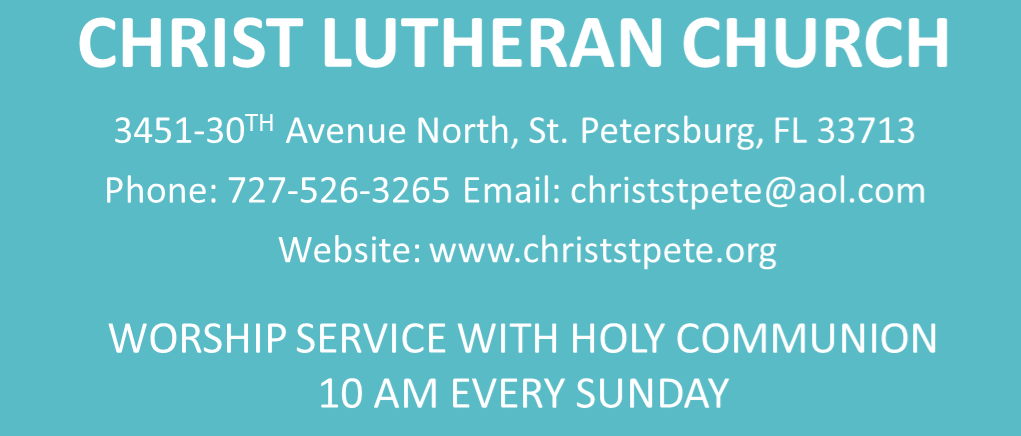History of the Bible - A Timeline
The History of how God made sure we had His Word in the Holy Bible is very interesting. Here are some of the major developments over time that brought us the truth of God’s Word in the Holy Bible:
The Old Testament, which contains the first 39 books of the Holy Bible, was handed down to us from the Holy Scriptures of the Jews. Originally written in Hebrew and Aramaic by Moses, Solomon, David and the Prophets through the inspiration of the Holy Spirit, these books were translated to Coine’ Greek in about 200 B.C. This translation was known as the Septuagint, because tradition says it was translated in 70 days by 70 Biblical scholars. The Holy Scriptures were translated from Hebrew into Greek, which was the lingua franca or language of commerce in the Mediterranean area after the conquests of Alexander the Great in the 300s B.C.
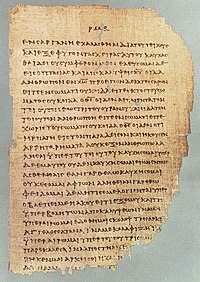
The books of the Bible were originally written on Papyrus and rolled into Scrolls before the Codex or book form became popular during Roman times. This s a copy of Papyrus 46, a surviving papyrus from the Septuagint. Using Parchment made from sheep skin was also popular in the early centuries of the church.
The Jewish Holy Scriptures were divided into several parts, including the Torah or Law, which was written by Moses and comprises the first five books of the Old Testament. Following the Torah are books of Jewish history, detailing the lives of the various Prophets God sent to enlighten His people with His promises to send a Savior and to encourage the people to have faith in this coming Messiah. The Old Testament also includes the Book of Psalms, mostly written by King David, which was used to praise God during Jewish worship services, probably set to music; and also the Book of Proverbs, written by Solomon, which includes truths the Jewish taught their people. This painting in Italy by Bellini shows the Transfiguration when Jesus brought both Moses and Elijah to visit Peter, James and John to show the importance of both the Law represented by Moses and the Prophets, represented by Elijah.
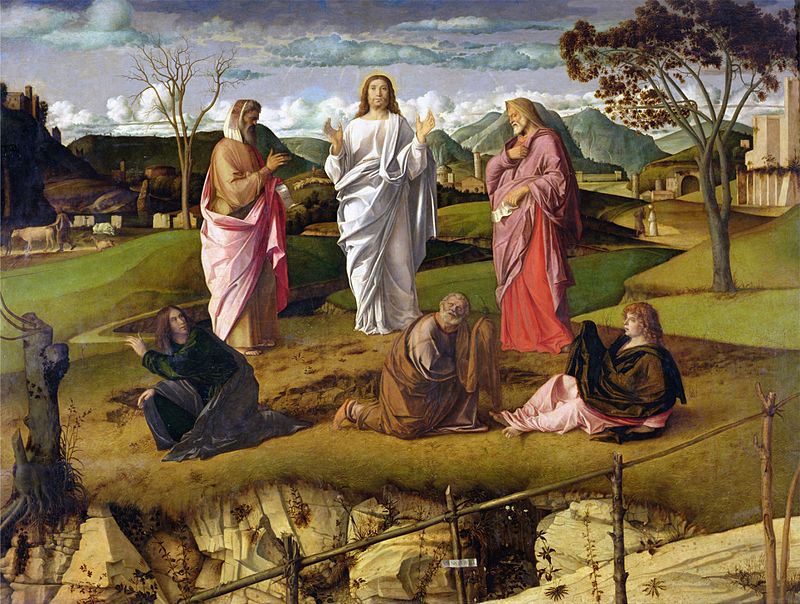
The Prophets, especially Isaiah in Chapter 52 and 53. foretold the coming of Christ in great detail, and Christ was born in Bethlehem of Judea, as prophecized, shared His mission of Love and Compassion, and died for our sins on the Cross about 33 years after his birth, rising again in glory and ascending into Heaven. For more information about the Life of Christ, please see our Large Stained Glass Windows webpage which gives Biblical references.
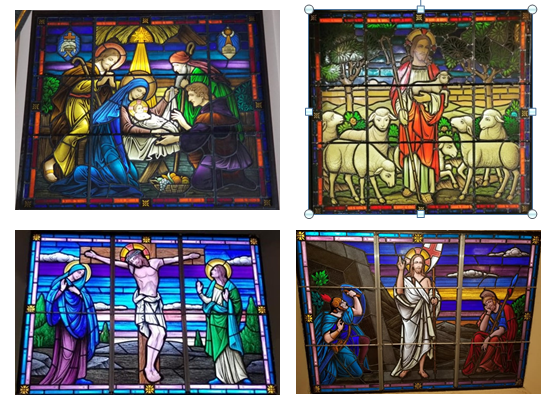
During His ministry here on earth, Jesus appointed 12 Apostles, and those were His closest witnesses to His miracles, His parables and His life and subsequent death on a cross. The Apostles were the ones who found the empty tomb on the first Easter Sunday and the ones the Holy Spirit descended upon on the First Pentecost, seven weeks later when the Apostles were gathered in Jerusalem to celebrate the Jewish Feast of First Fruits. Four of these Apostles, Matthew, Mark, Luke, and John were also prolific writers, inspired by the Holy Spirit to bring us the truth about the Life, Death and Resurrection of Jesus Christ. Illustration is from the Pentecost window at Christ Lutheran Church showing the Holy Spirit descending on the Apostles on that first Pentecost Sunday, which is also considered the birth of the Christian church.
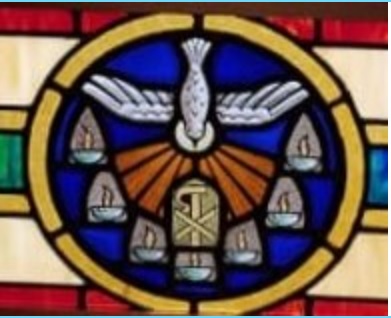
Matthew, Mark, Luke and John wrote the first five books of the New Testament, the Gospel of Matthew, the Gospel of Mark, the Gospel of Luke and the Gospel of John, and a second book by Luke detailing the first years of the ministry of the new Christian church entitled the Book of Acts. John also wrote the last book of the Bible, known as Revelations, and three Epistles or Letters known as John 1, John 2, and John 3. The four windows at Christ Lutheran Church represent Matthew, Mark, Luke and John as their historical symbols.
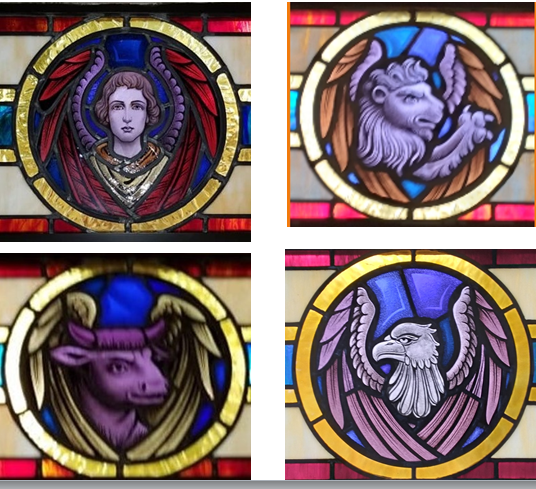
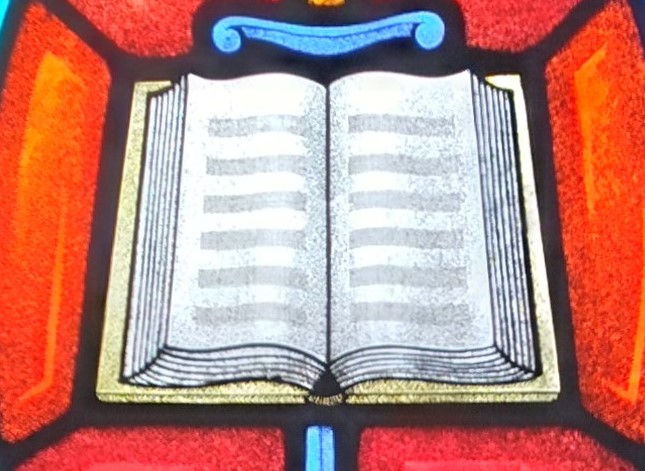
St. Paul, a Roman citizen who came to believe in Christ after His death and Resurrection, also wrote a large number of Epistles. Other Epistles were written by Peter, John, James and Jude. By the end of the First Century, all the Books of the Bible had been written and all of the witnesses to the Life of Christ had died and joined Christ in Heaven. This illustration is from the St. Paul window at Christ Lutheran Church.
The Slovak Evangelization Center, a mission in alliance with the North Amerian Lutheran Church, has posted this article entitled ANCIENT EVIDENCE FOR THE EXISTANCE OF JESUS FROM NON-CHRISTIAN SOURCES, available online in English and Slovak at: https://chcemviac.com/clanky/staroveke-dokazy-o-jezisovej-existencii-z-nekrestanskych-zdrojov/
The Nicene Council – In 325 A.D., the growing Christian Church convened a Council in Nicea, in Asia Minor to formally settle which books were inspired by the Holy Spirit and belonged in the Bible and which other books, written later, where only stories written by other people and considered heresies. There were quite of a few of these fake gospels written in the second and third century and the Church wanted to make sure people were only hearing the truth about Jesus, His Life, His ministry and His Death and Resurrection. The 39 Books of the Old Testament and the 27 Books of the New Testament were canonized or recognized as official, at that time.
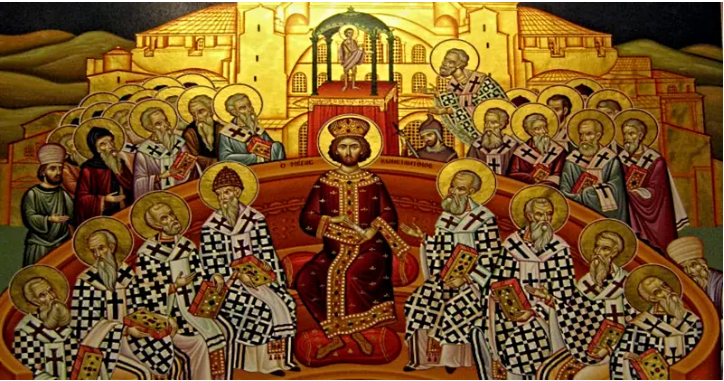
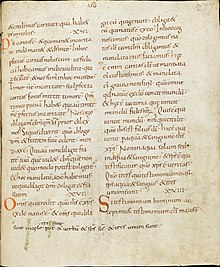
By the end of the Fourth Century, the Bible had been translated into dozens if not hundreds of languages and spread around the known world. One of these languages was Syriac. Some ancient pages of a Syriac language Bible were recently discovered by archaeologists, on parchaments that had been erased and reused. Modern technology is able to “see” these old enscriptions giving use a clue of the kind of Scripture versions available in the second and third centuries. The Church in Rome dominated the Churches at the time, and was worried about heresies slipping into various translations. Therefore, St. Jerome was given the task of translating the Bible from Coine’ Greek to Vulgar (common) Latin, which was more in use by the common people by that time period. This was due to the influence of the Roman Empire which lasted until 465 A.D. Unfortunately, St. Jerome did not translate the Bible with complete accuracy. He mistranslated some of the Greek, especially the word “Metanoia”, which is supposed to mean “Repent and turn back to God”, but was translated as “Do Penance” instead. Users of the Latin Bible spent time doing things to achieve Salvation instead of relying on the Grace that only comes from Faith in Jesus. Scholars estimate today that the Latin Vulgate Bible differs at least 7 percent from the Greek version.
During the Middle Ages, the Bible only allowed to be read in Latin. Since there were very few books and all were hand written, it was easy for the Church to mandate only one language. The Holy Bible was however, translated from Latin into an early form of English by a man by the name of John Wycliffe. The Church denounced his translation, had him killed and later burned his bones in revenge. Wycliffe’s translation was from the Latin version.
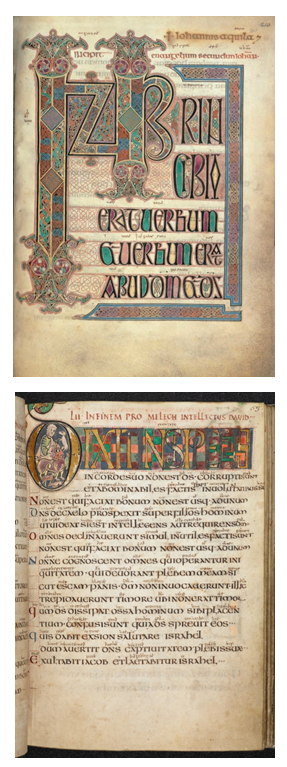
Because the printing press had not yet been invented, the only way for people in the Middle Ages to read the Bible was to read from hand written manuscripts. These were copied by monks in various monastaries throughout Europe, and contained beautiful hand drawn and illustrated pages. Some of the pages even had illustrations that used gold ink or gold leaf. Most churches were lucky to own even one Bible and it would be chained to the stand on which it was displayed to keep it from being stolen! These pages today are kept in art museums and libraries. Christ Lutheran does NOT own any illuminated Manuscripts.
These illustrations above are from the British Library in London, England, UK, and probably come from the Lindisfarne Gospels, hand-lettered and illuminated, and hand-published in the early 700’s A.D. at Lindisfarne, a monastary in Anglo-Saxon England. The Lindesfarne Gospels included the Four Gospels and and letters from St. Jerome dating from the 400s A.D. Other famous Illuminated Manuscripts include the Book of Kells from around the same time period, which resides in Trinity College Library in Dublin, Ireland. See illustrations below of Christ Enthoned and The Gospel of John title page from the Book of Kells. For more information about these and other Illuminated Manuscripts please see:
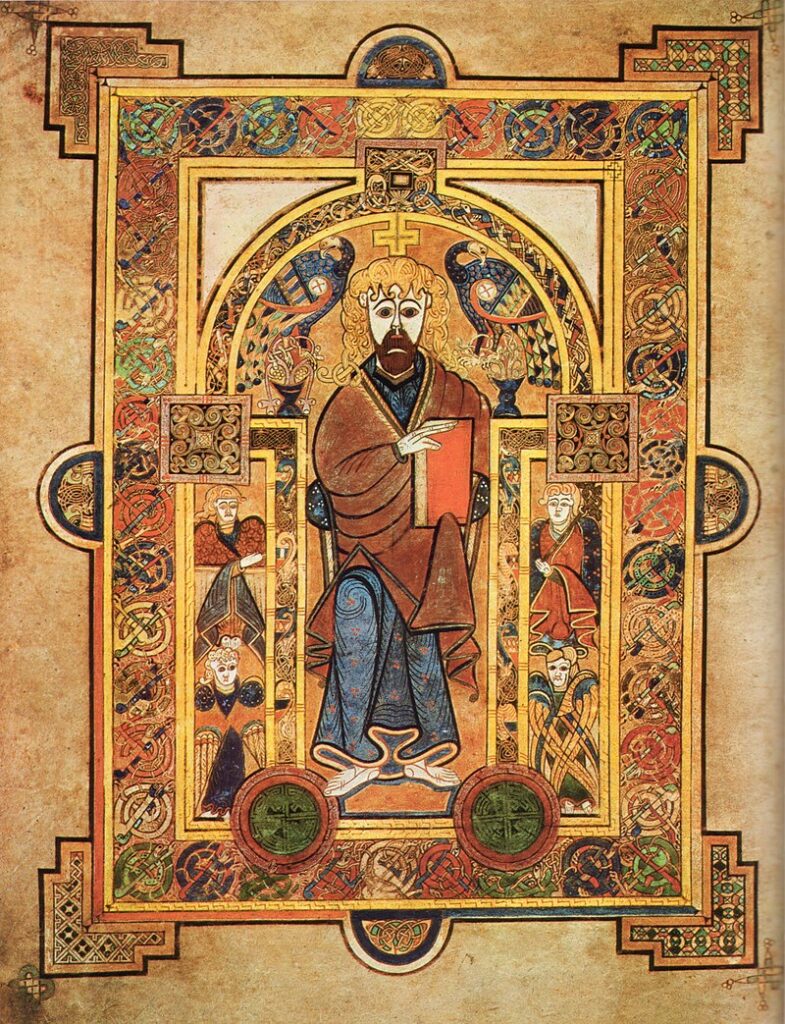
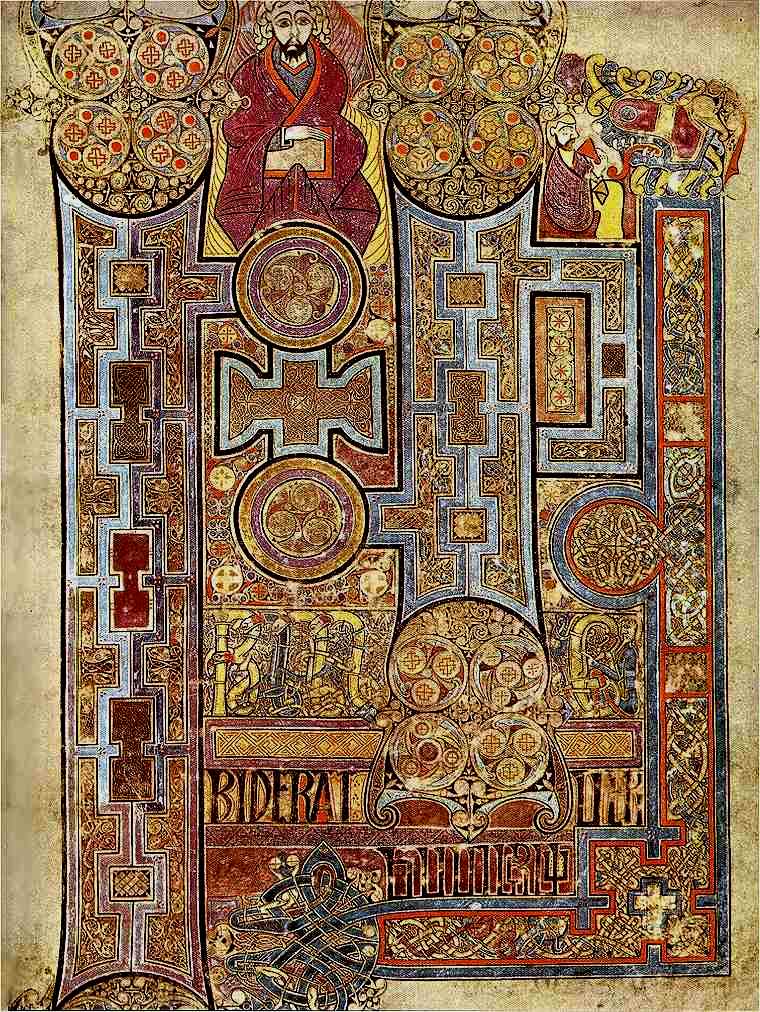

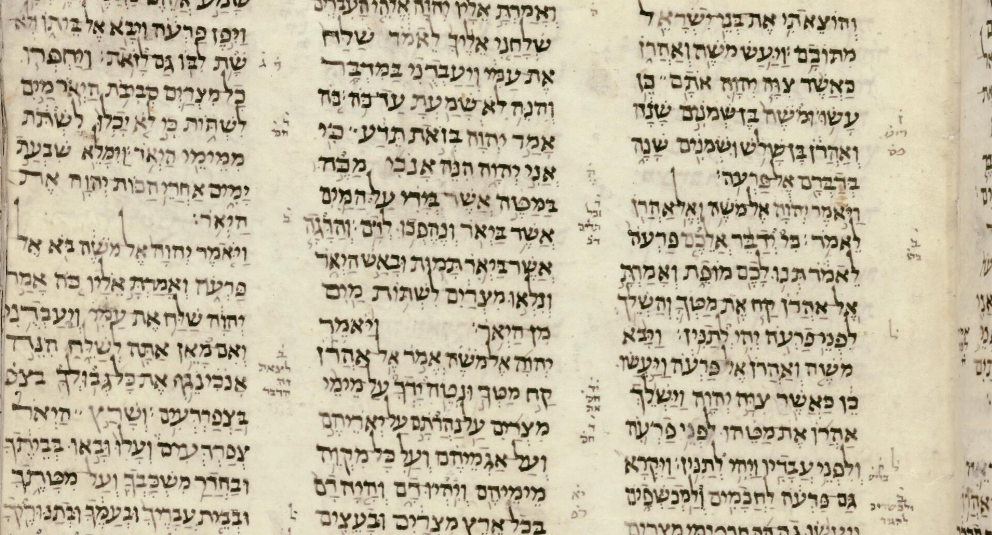
During the Middle Ages, the Old Testament was also published by the Jews in Hebrew for Jewish people but did not include the New Testament. This copy of the Old Testament is known as the Codex Sassoon version of the Holy Scriptures and dates from about 900 A.D. It is written entirely in Hebrew and not used by Christian churches. It is however, a valuable early text which sold at auction recently for more than 38 million dollars. The Codex Sassoon added “jots” and “tittles” to their script to record vowel sounds as shown in the photo, proving they did use this form of writing as early as 900 A.D. Scholars still debate some of the early pronunciations of Hebrew words, especially the Tetragrammaton, which is four Hebrew letters that stand for Yahweh or Yahovah, depending on to which scholar you listen.
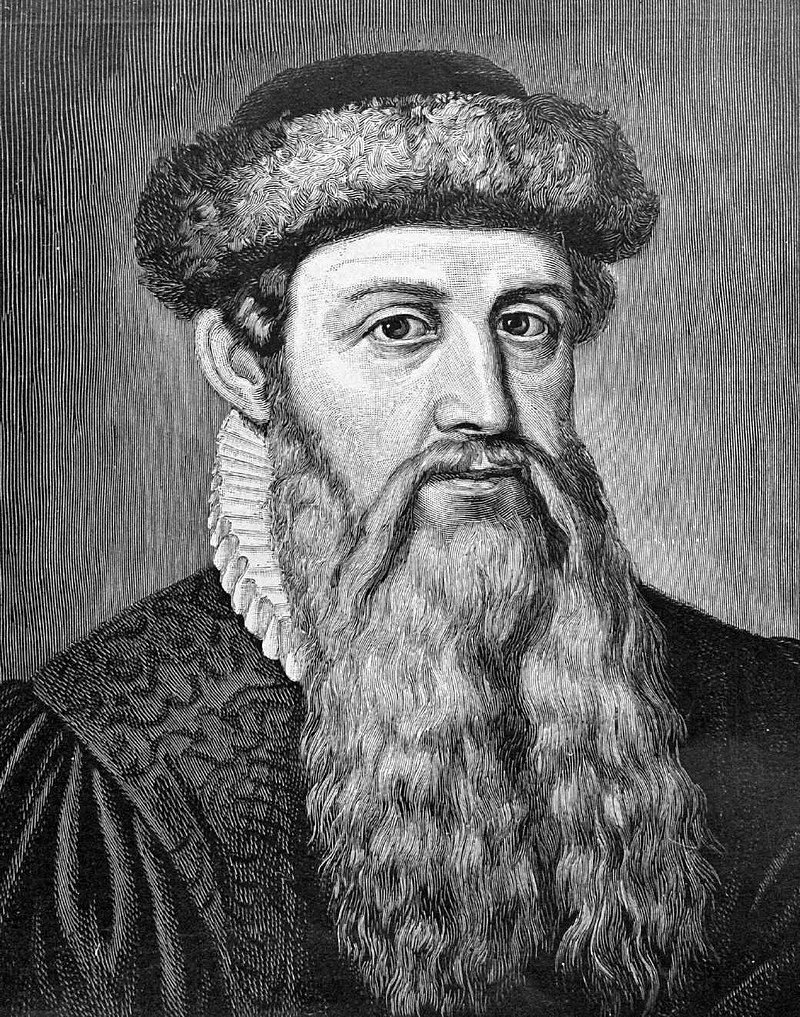
This woodcut portrait of Johannes Gutenberg was created after his death. It is posted on wikipedia with an interesting detailed article about his life at: https://en.wikipedia.org/wiki/Johannes_Gutenberg.
For a description of differences between Papyrus, Parchment, Vellum and Paper, see: https://www.adelaide.edu.au/library/special/exhibitions/cover-to-cover/papyrus/#:~:text=Vellum%20can%20usually%20be%20distinguished,to%20a%20somewhat%20irregular%20surface.
In 1453, Johannes Gutenberg invented movable type for the printing press, enabling finally the printing of the Bible. He printed his Gutenberg Bible by 1454 or 1455, which was a beautiful printed copy of the Latin Vulgate with a few changes, printed on hand made paper and bound in Codex form. It was still expensive and time consuming to print a Bible, but it much quicker than having monks and scribes letter it by hand. Woodcuts were still used for some of the illustrations, however the wealthy patrons who could afford his Bible would hire artists to illuminate or illustrate their copies of the Bible.
It was forntunate that the printing press was invented at that time, because it coincided with the fall of Constantinople and the Byzantine Empire to the Ottoman Turks. The Turks were Muslims and Christianity was not tolerated in the Ottoman Empire. As a result, many Greek Byzantine manuscripts were being brought to Western Europe with those escaping Ottoman rule. The West now had more access to Greek Scripture to compare with the Latin Vulgate for accuracy.
After about 1000 years of domination of the Church by the Church in Rome, the Church had strayed too much from the original meaning of the Gospels. Few could read Latin anymore including many of the priests A monk named Martin Luther, born in 1483 who became a priest was very bothered about the Church’s insistence on doing penance and concerned about the Church’s practice of selling indulgences (free tickets to heaven) as a fund raiser. Martin Luther was a scholar of early Biblical texts in Greek and soon discovered that the Bible originally told us we are saved by Faith, not by Works, as recorded in St. Paul’s Epistle to the Romans. The original Greek manuscripts stated this and the Roman Church has mistranslated this important message. Martin Luther tried to debate the Church, and famously nailed his 95 Theses detailing his issues with the Roman Church’s interpretation of the Bible to the community bulletin board which was the door of the Whittenberg Cathedral on October 31, 1517. Luther’s discoveries were ignored by the Roman Church, and the Church leaders fought against Luther’s ideas because they disabled the power the Church had over its people. Thus began the Protestant Reformation. Note: We have no evidence of Luther using the Codex Sassoon as it is now known in his translations, but his translating from Eramus’ Greek=Latin Bible, first edition, publishied in 1516 has been proven.
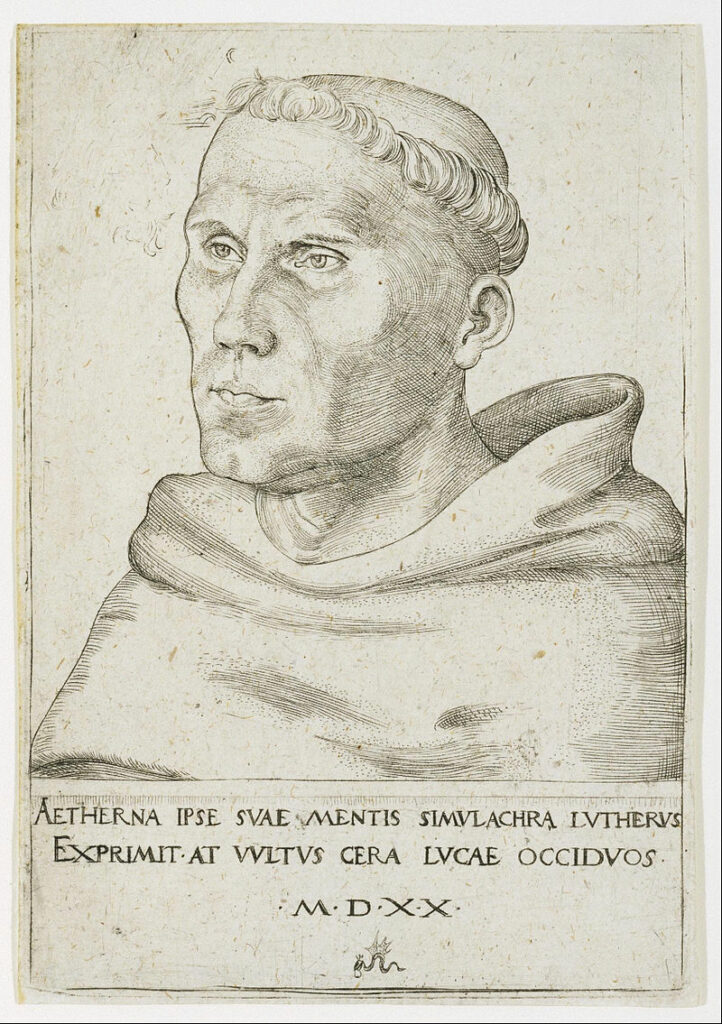
This woodcut of Luther by Lucas Cranach is from 1520. Below: The door of Whittenburg Cathedral is now enscribed with the 95 Theses of Martin Luther. Originally it was the community bulletin board in 1517.
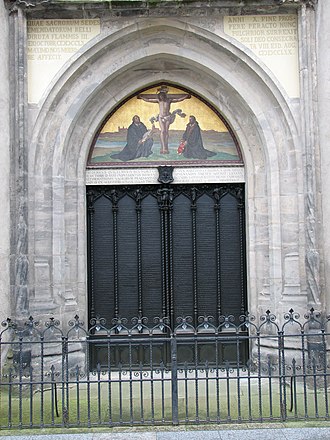
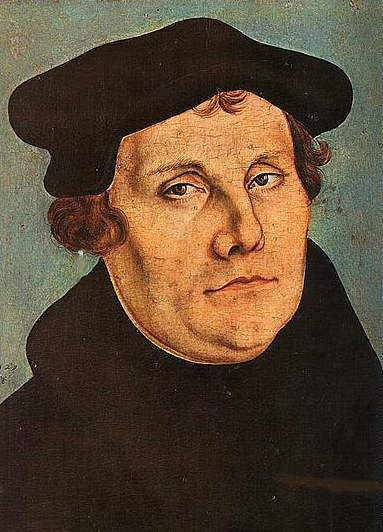
This painting of Martin Luther is by Lucas Cranach a contemporary and friend of Luther. The painting likely dates from the early 1520s, as Luther stopped wearing monk’ clothing by about 1524 as monastaries and convents were closing during the Peasant’s Revolt.
Martin Luther believed everyone should have a chance to read the Bible for himself and not rely on the Roman Church which had its own agenda and interpretation of the Holy Bible. He risked his life to translate first the New Testament about 1522, and later the Old Testament by 1534 into the German language of his country. Although his translation was not the first Bible in German, it was the first German Bible to be translated from the original Greek and Hebrew, and not just a retranslation from the Latin as other German Bibles had been. The invention of movable type by Guttenberg in 1453 enabled copies of Luther’s translations and other writing to quickly spread around the Holy Roman Empire. Luther’s translation of the New Testament relied heavily on the 1516 First Edition of Desiderius Eramus’s translation of Greek Byzantine texts in Eramus’s Greek-Latin New Testament.
In 1530, the Augsburg Confessions were successfully presented to the Holy Roman Emperor as the beliefs of the Lutheran Church, and the sixteenth century saw many other translations of the Bible due to the success of Martin Luther. Most of the translators were persued by the Church and put to death. In 1535, William Tyndale was burned at the stake for his beautiful English translation of the Bible. His last words were a plea to God to open the eyes of the king. This original woodcut is probably from Albrect Durer.
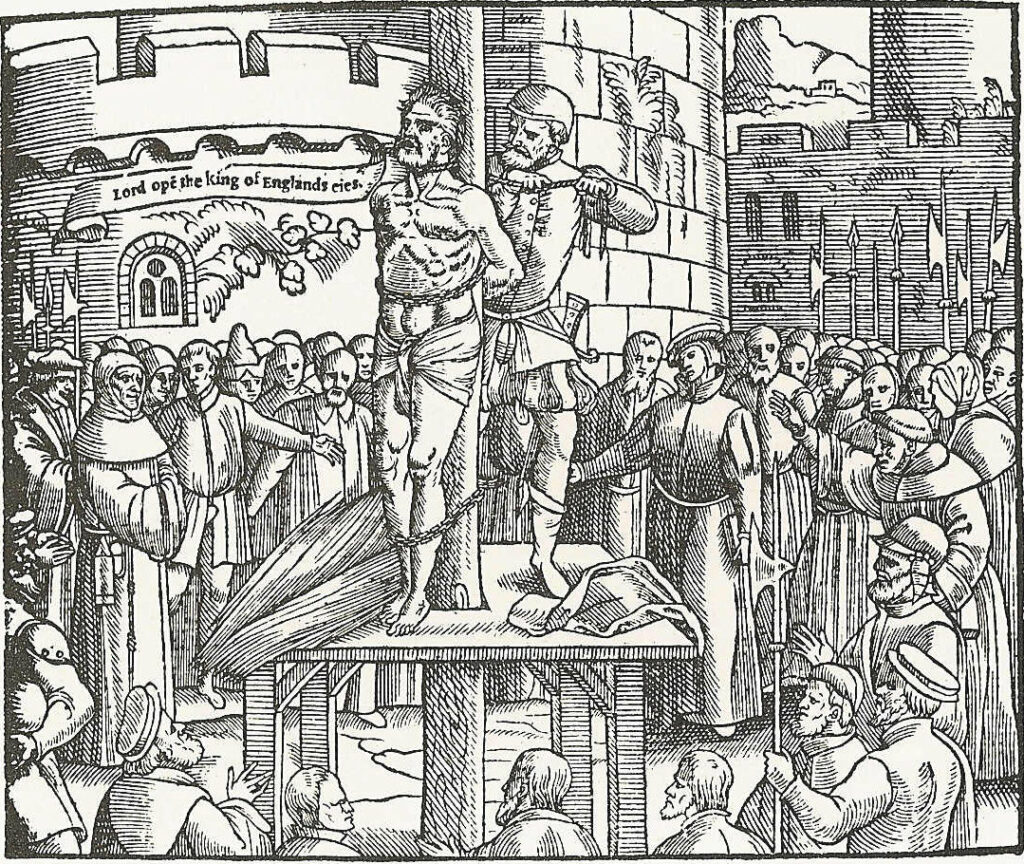
The sixteenth century also saw the publication of other Bibles in English. In 1535, Miles Coverdale was able to publish an English version of the Bible outside of England. Copies found their way back to England and were widely circulated. This Bible was known as the Coverdale Bible. Unfortunately, he translated from the Latin Vulgate instead of Tyndale for that edition. But Coverdale had worked with Tyndale and others and was involved in more English translations of the Bible than anyone else. He was probably wise to use the Latin Version because he published with a few years of Tyndale’s martyrdom at the command of Henry VIII. He published the Great Bible, in 1538, which compared the Latin Vulgate to the English Bible as a two- language Bible. Coverdale was able to get authorization for this Latin Vulgate translation into English from the Henry VIII.
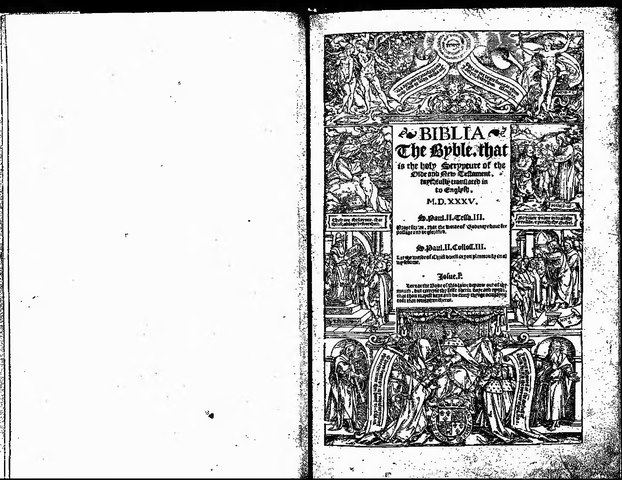
The Peace of Augsburg Treaty, signed in 1555, gave each principality the right to determine the religion of their subjects, rather than allowing the Holy Roman Emperor to make that decision. Many European wars over who would control religion were fought after this treaty was enacted, including the Five Wars of Religion in France and the 30 Years War (1618-1648) in much of Western Europe, This decentralization of the control of the Church enabled additional copies of the Bible in English and other languages to become more commonplace. In 1560, the Geneva Bible was published, and it later became known as the Pilgrim’s Bible, as this is the Bible that was brought to North America by the English Pilgrims in 1620, and widely shared on our continent. The Geneva Bible was published in 1560 in Geneva by English religious exiles, and probably favored by the Pilgrim’s due to their opposition to the Anglican Church which was using the King James Version mentioned below. Geneva, Switzerland was controlled by John Calvin at the time of the publication of the Geneva Bible. It was unique because it was the first English Bible to include Chapter and Verse notations, and it used this Times New Roman font rather than the older Gothic fonts common in Bible publications. The Geneva Bible also contained commentaries in the margins, some which did not agree with the Anglican theology of the English throne. Another sixteenth century English Bible was the Bishop’s Bible, published with royal authority in 1568.
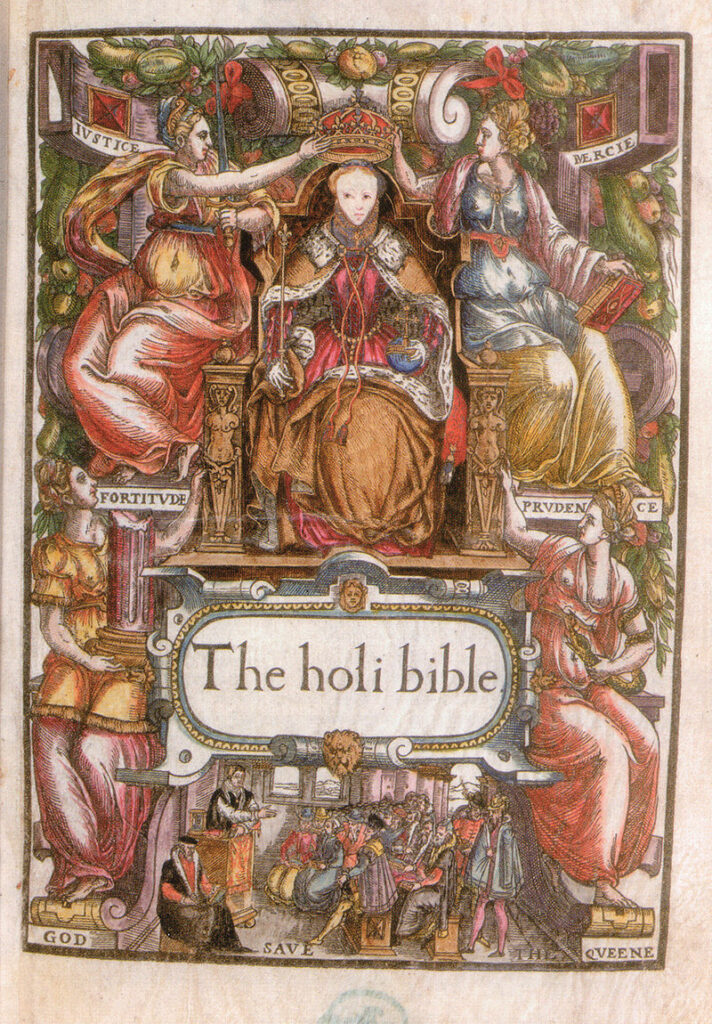
Another sixteen century English Bible was the Bishop’s Bible, published by Anglican Bishops with royal authorization in 1568. It was to succeed the Great Bible of 1538-9 as the official Bible of the Anglican Church, but was not a successful edition. The Anglican Bishops of that time wanted to take over rule of the church from the throne, but they also wanted to give churches newer Bibles that did not have the Calvinist slant of the more popular Geneva Bible. Notice the spelling differences of the 1500s. This beautifully illustrated woodcut was included in the Bishop’s Bible and featured Queen Elizabeth I, including a motto at the very bottom stating “God Save the Queene”
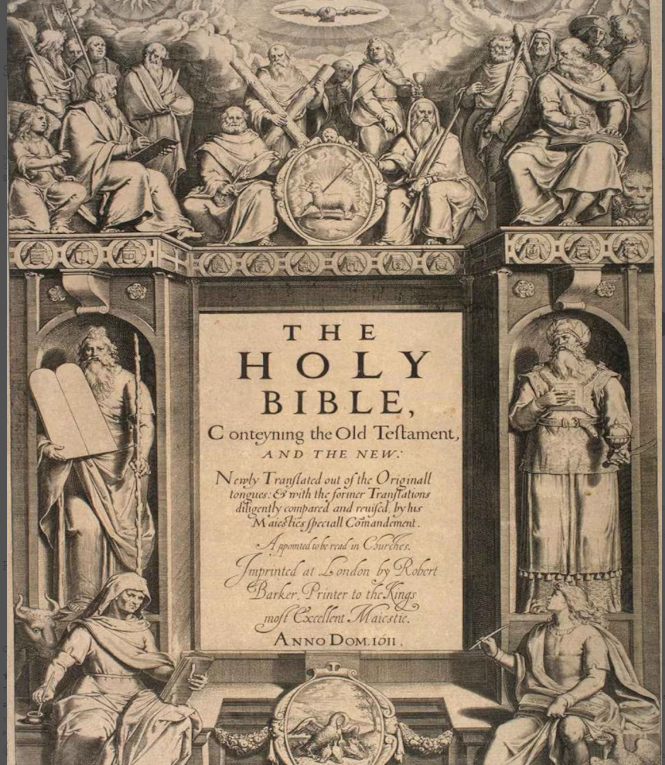
By the seventeen century it became easier to publish a Bible in a language other than Latin and to publish translations closer to the translation by Luther. In 1611, King James I, a Roman Catholic King of England, allowed the publication of the King James Version of the Bible in English. Its beautiful Shakeperean prose is still in use today. It has been said that most of this translation drew from the earlier work of William Tyndale. This title page is from the British Library collection in London.
In the centuries since the publication of the King James Version, many other English translations have been published with slight updates and modifications due to the constant evolution of the English language The Revised Standard Edition (RSV) published in the 1800s, The New International Version (NIV), published in 1972, The New King James Version (NKJV) published in 1979, and the English Standard Version (ESV) published in 2001 are all based on the King James Version which in turn is based on Luther’s translations from the original Greek and Hebrew. The 20th and 21st Century have seen many version of the Bible published in English, however not all are considered accurate or acceptable by the Lutheran Church because they differ from the translations of Martin Luther. The Roman Catholic Bible adds additional books to the Bible for instance, and several other Bibles published by other denominations are also considered inaccurate translations. Christ Lutheran Church accepts the KJV, the NKJV, the RSV, and the ESV as true and accurate translations of the Bible.
SOURCES:
For a more detailed article on the publication of the Bible in several languages beginning in the late Middle Ages and continuing today, please see this article about Martin Luther translating the New Testament: https://www.christianitytoday.com/history/2017/october/most-dangerous-thing-luther-did.html
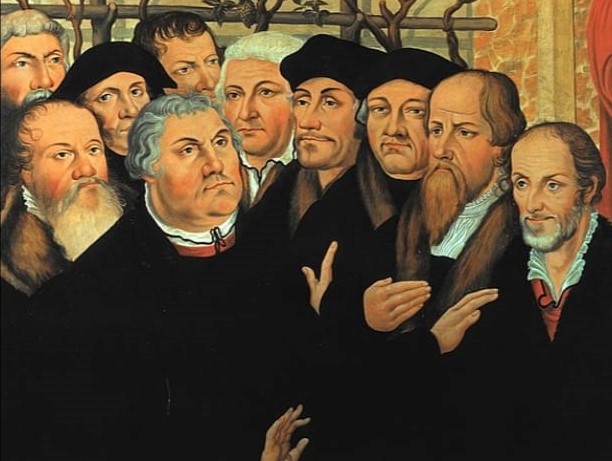
For an interesting group of biographies of early translators of the Bible into English, you might enjoy this link from Bible Heritage Exhibit: https://www.biblicalheritageexhibit.com/blogs/history-of-the-english-bible
For a fascinating look at the important manuscripts from the history of publication of the Bible, also see: https://inkandblood.com/

